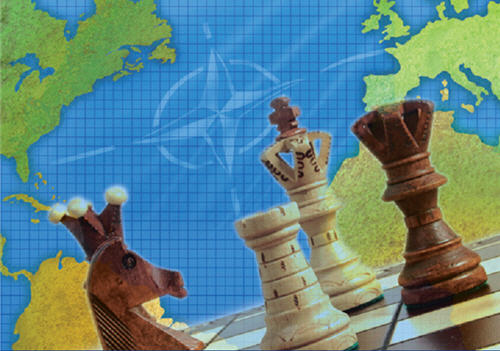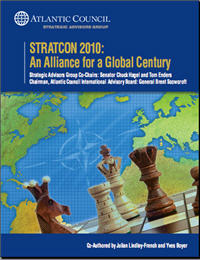
NATO risks becoming a relic of the Cold War unless it finds a renewed sense of solidarity and political will while framing its new Strategic Concept. That’s the central message of STRATCON 2010: An Alliance for a Global Century, a report by the Atlantic Council’s Strategic Advisors Group.
The project, co-chaired by General Brent Scowcroft, Dr. Thomas Enders, and Senator Chuck Hagel, provides a blueprint for avoiding this outcome, offering concrete recommendations for how the Alliance must be transformed in order to meet the global threats and challenges of the 21st Century. The report was co-authored by SAG members Dr. Julian Lindley-French and Dr. Yves Boyer.
Introduction
 NATO’s purpose has three key elements: to embody the mutual commitment to the protection and defense of allies in the event of an attack; to help resolve international crises when invited; and to cooperate with others to resolve common security threats. The overriding goal of the Alliance is to make NATO citizens feel safe. NATO safeguards the freedom, common heritage and civilization of the Alliance, founded on the principles of democracy, individual liberty and the rule of law, and promotes transatlantic security and well-being based on the preservation of peace and stability in areas vital to those ends. NATO is thus a twenty-first century security alliance and the transatlantic security forum combining political and military power.
NATO’s purpose has three key elements: to embody the mutual commitment to the protection and defense of allies in the event of an attack; to help resolve international crises when invited; and to cooperate with others to resolve common security threats. The overriding goal of the Alliance is to make NATO citizens feel safe. NATO safeguards the freedom, common heritage and civilization of the Alliance, founded on the principles of democracy, individual liberty and the rule of law, and promotes transatlantic security and well-being based on the preservation of peace and stability in areas vital to those ends. NATO is thus a twenty-first century security alliance and the transatlantic security forum combining political and military power.
The Core Message
The defining feature of the Strategic Concept to be agreed at this fall’s Lisbon Summit is that for the first time NATO’s purpose, principles and partnerships must necessarily be considered in a global context. Strategic Concept 2010 will be judged by the extent to which NATO adapts successfully to new circumstances and thus ensures the Atlantic Alliance remains a strategic cornerstone of international security.
What NATO is for is the question that Strategic Concept 2010 must answer. The Strategic Concept, and the process of creating it, must also communicate NATO’s purpose to allies, potential adversaries, partners and peoples at a time when the public finances of many members are poor. Today, NATO’s enduring mission remains to promote stability and security through effective political approaches to conflict prevention and resolution, built on credible military capabilities to support deterrence and provide strategic reassurance to all allies. This will require the Alliance to play its full role in the security and defense of the Euro-Atlantic community by striking a balance between active defense, credible deterrence, both conventional and nuclear, and ensuring that risks and threats are kept at strategic distance through modern and deployable armed forces. NATO must thus act as the natural forum for the discussion of defense and security issues by Europeans, Americans and Canadians who share the same democratic values and commitment to freedom and respect for human rights. To that end, NATO remains the central link uniting the twin North American and European security and defense pillars when vital interests are at risk.
Strategic Concept 2010 will be the first time that the Alliance properly considers its role well beyond the transatlantic area. This new reality must strengthen the determination of the allies to modernize NATO forces and structures given the many lessons from operations over the last decade. Such a goal will require the transformation of Alliance strategic and operational planning capabilities, reinforced by sufficient numbers of deployable armed forces. Given the downward pressure on allied defense budgets, enhanced effectiveness will only be achieved through much greater efficiency.
NATO’s original 1949 covenant is as relevant today as then: to guarantee the safety and security of all member state citizens by means of a potent military alliance built on credible armed forces and close political cooperation. Collective defense, as enunciated in Article 5 of the Treaty of Washington, must and will remain central to the Alliance. However, the Alliance must also re-energize both Articles 3 and 4 and consider the future role and structure of the Alliance in that context. Article 3 emphasizes effective self-help and mutual aid as part of both an individual and collective capacity to resist armed attack. Article 4 emphasizes the need for consultation whenever the territorial integrity, political independence or security of any member is threatened.
Strategic Concept 2010 must once and for all end the post-Cold War strategic vacation of many members and re-establish a clear contract among all members of the Euro-Atlantic Community, whereby all gain security in return for the equitable sharing of responsibilities. Without over-militarizing security policy, Strategic Concept 2010 must make the case for modernizing and enhancing the core competence of the Alliance: credible fighting power. In effect, Strategic Concept 2010 must mark the launch of a program of modernization that leads to a new NATO relevant and credible in a rapidly changing world, in which the dark side of globalization offers the dangerous new possibility of smaller groups gaining access to ever greater destructive power.
Ten Principles for Strategic Concept 2010
Strategic Concept 2010 must embody a set of principles that underpin the commitment to sustain political vision and military effectiveness and provide the narrative supporting modernization of NATO forces:
1. Restate the Alliance’s Political Mission. All members of the Atlantic Alliance retain a fundamental commitment to liberty, democracy, human rights and rule of law which underpin both the political mission and strategy of the Alliance.
2. Balance Solidarity, Strategy and Flexibility. In a fractured world, a complicated partnership is unlikely to generate unity of purpose and effort. Consensus, thus, will always be to an extent conditional with the need for flexibility paramount. To that end, a new contract is needed among and between all members of the Euro-Atlantic community that enshrines flexibility as the strategic method of the Alliance even as it spells out those core areas of defense where solidarity is both automatic and absolute. Only by balancing political and strategic realities will such a contract move NATO beyond a spurious rhetorical role to ensure each member gains security from all the rest in return for the equitable sharing of responsibilities. Such a goal will demand that NATO acts as the transatlantic security forum for political discussion given the challenges the allies face together.
3. Promote Political Flexibility. The world today is too complex for the Atlantic Alliance to manage critical security challenges alone. However, in such an environment, a strong Atlantic Alliance will be essential for the security and defense of the Euro-Atlantic area and beyond. Equally, there will be times when having a United Nations, European Union or OSCE flag on an operation, rather than a NATO flag, will afford a better chance of success. In such circumstances, NATO should be able and willing to play an enabling role.
4. Reestablish the Link between Strategy and Fighting Power. NATO is first and foremost a military security organization. Critical to both its purpose and role is the generation, organization and application of military effect. At the heart of Strategic Concept 2010 must be a commitment to enhance fighting power with capabilities and capacities designed to ensure the allies remain the world’s preeminent military group. Even the defense of members today requires advanced deployable armed forces with force modernization tailored to such an end.
5. Strike a Better Balance between Protection and Projection. For the Atlantic Alliance to play its wider military security role, the military stability and security of Europe (both members and partners) – and reassurance of all – remain central to NATO’s mission. Therefore, a better balance is required, based on assessed need, between protection of the home base against threats such as terrorism and the projection of stability.
6. Recommit to Success in Afghanistan. It is critical that NATO succeeds in the wars in which it engages. Therefore, the commitment to succeed in Afghanistan will need to be restated with conviction and demonstrated through action on the battlefield (in line with the Obama administration’s decision to push towards a stability breakthrough).
7. Build Planning and Information Power. Planning must incorporate at earlier stages new partners and a much broader range of sources of information. That will require far more effective sharing of intelligence, the better use of open sources and new knowledge partnership.
8. Strengthen the Links among Command, Operations and Modernization. Given the changing roles and missions of Alliance armed forces, radical modernization should become the key task for Allied Command Transformation (ACT), based on effective analysis, lessons learned, creative thinking and operational experimentation. To assure such a goal, a new relationship should be forged between Allied Command Operations (ACO) and ACT with a specific focus on reform of command structures. ACT should also link up with the European Union’s Common Security and Defense Policy (CSDP). Strategic Concept 2010 will have to consider military perspectives and requirements after Afghanistan, in particular reform of the NATO Command Structure, the NATO Response Force (NRF) and the High-Readiness Forces (HRF). In particular, modernized decision-making and command structures which allow for effective and flexible command and control are needed at all levels, together with a thorough assessment of those non-military capabilities and partnerships central to NATO mission success.
9. Modernize the Link between Minimum Deterrence and Arms Control. The defense of the Euro-Atlantic community against any resurgent major threat should and must remain firmly based on credible deterrence, which must incorporate a credible minimum nuclear component, the role of which must be reaffirmed by Strategic Concept 2010. Equally, the Alliance must be in the lead to strengthen arms control regimes, both nuclear and conventional, as well as non-proliferation.
10. Modernize Defense Education. Effective defense education is a critical component to mission success at every level of command. Indeed, defense education is the great unmined treasure of the Alliance. However, education efforts across the Alliance are in urgent need of modernization to put the needs of the learner properly at the center of a technology-rich commitment to life-long learning. Such investment will strengthen the quality of individual members of Alliance forces, including the full range of skills needed for counterinsurgency, counterterrorism and integrating military and non-military instruments of power and influence.
Strategic Advisors Group:
To tackle the tough issues facing NATO and the transatlantic community, the Atlantic Council created the Strategic Advisors Group (SAG). Co-chaired by Atlantic Council Chairman Senator Chuck Hagel and Airbus CEO Tom Enders, the SAG is comprised of North American and European preeminent defense experts. Founded in 2007 by then-Atlantic Council Chairman General James L. Jones, General Brent Scowcroft, and former Norwegian Minister of Defense Kristin Krohn Devold, the SAG provides timely insights and analysis to policymakers and the public on strategic issues in the transatlantic security partnership through issuing policy briefs and reports, hosting strategy sessions for senior civilian and military officials, and providing informal expert advice to decision-makers.
Recent Atlantic Council NATO Publications:
- Afghanistan, Pakistan and NATO’s Strategic Concept
- NATO Defense Capabilities: A Guide for Action
- NATO Initiatives for an Era of Global Competition
- NATO’s Nuclear Policy in 2010
- NATO Reform and Decision-Making
- Article 5 and Strategic Reassurance
- The U.S., NATO and the EU: Partnership in the Balance
- The Challenge: NATO Amidst Geopolitical Realities
- A New Transatlantic Compact for NATO
The SAG and its activities are generously sponsored by the Scowcroft Group, EADS North America, and Airbus.
Image: stratcon-2010-crop.jpg
